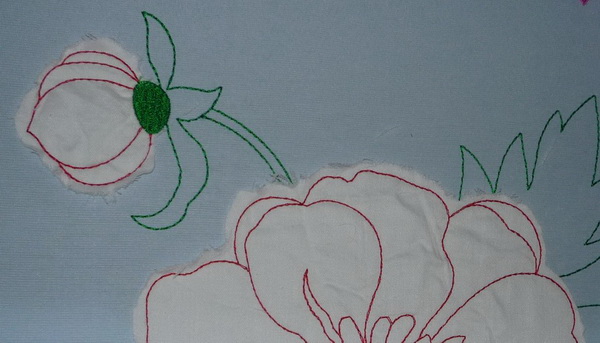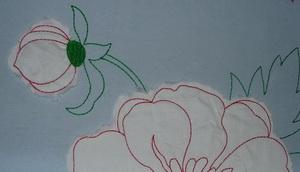Original text by Marina Belova
Appliqué with ragged edges is, perhaps, the easiest type of all in the machine embroidery. Easy both in digitizing and in making. This appliqué contains a very moderate amount of stitches.
I will consider the method of manually trimming the extra appliqué fabric right in the hoop.
The technology of creating appliqué is simple and includes 2 steps:
- Embroidering an outline that will show where to place the appliqué fabric. Then the machine makes a stop and the hoop comes out for positioning of appliqué fabric sprayed with temporary spray adhesive.
- Appliqué fabric is usually stitched with running stitches or zigzags to hold it in place. After that, the machine makes another stop and the hoop comes out for cutting the fabric directly in it.
The fabric is cut in a free-hand, you may even say artistic, way, 3-5 mm from the edges. You can fray the edges afterward. In this way, for example:

Edging
A several-fold running stitch is habitually used for an appliqué with ragged edges. Satins with ragged edges, small zigzags, motifs and whatever else your imagination can conjure, can be used as well.
Digitizing by hand
- Creation of an outline that will show where to place the fabric.
- Insert a stop so that the hoop will come out for positioning of the appliqué fabric. Every type of machine has its own way of adding commands.
- Creation of an outline that stitches the appliqué fabric to the base one. Usually, several running stitches are used with 2 mm stitch length. Don't forget the tie-offs!
- Insert a stop so that the hoop will come out for trimming. Every type of machine has its own way of adding commands. If there will be no embroidery after the creation of the appliqué, you can trim the extra fabric after unhooping.
General recommendations on creating the appliqué with ragged edges
- In order to achieve a worn vintage look, better choose 100% cotton twill as your appliqué fabric and wash it prior to the embroidery. The appliqué fabric needs no stabilizing, otherwise, the desired ragged edge effect will not be achieved – the stabilizer will not allow the edges to fray.
- Better stitch with the threads matching your base, not your appliqué fabric, in color. After washing, the edges of your appliqué will become even more frayed and the stitches will not be visible anymore.
- To achieve even a more ragged edge, you can add notches and dents to the lines.



There are no reviews to display.